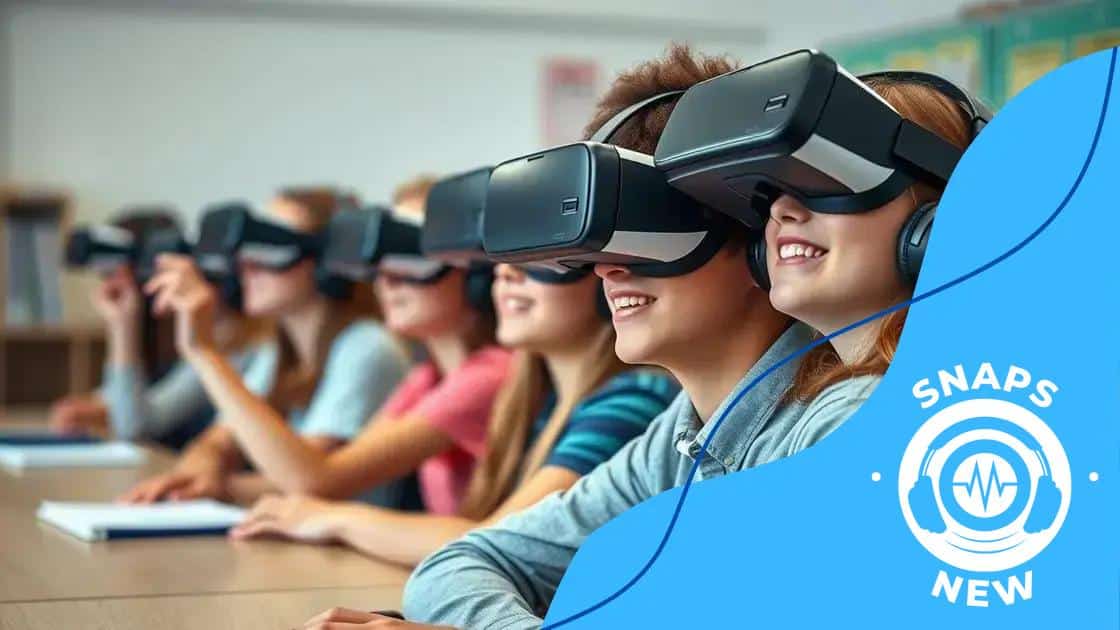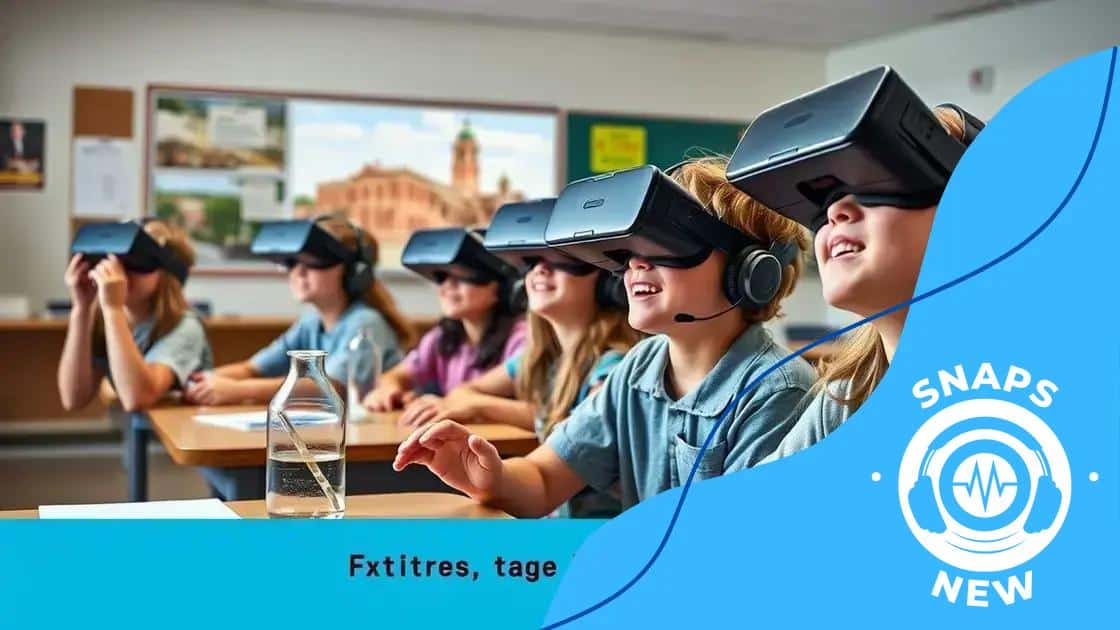Virtual reality in classrooms: transforming education

Virtual reality in classrooms offers immersive learning experiences that enhance engagement, improve retention, and promote personalized education while presenting challenges like cost and teacher training requirements.
Virtual reality in classrooms is reshaping how students interact with learning materials. Imagine diving into historical events or exploring distant planets without leaving your seat! This article delves into the exciting possibilities that VR brings to education.
Understanding virtual reality technology
Understanding virtual reality technology is essential for grasping how it can revolutionize education. It involves creating a simulated environment that can mimic the real world or present entirely new experiences. This means students can explore places they might never visit in real life, such as ancient civilizations or outer space.
With virtual reality, engagement levels can soar. Traditional teaching methods often can’t compete with the immersive nature of VR. Imagine students learning about the human body while being able to walk through it in a three-dimensional space! This kind of learning encourages curiosity and improves information retention.
Key Features of Virtual Reality
Several key features make virtual reality technology exciting for classrooms:
- Immersion: Students feel as if they are part of the experience.
- Interactivity: They can interact with objects, making learning hands-on.
- Accessibility: VR can make difficult subjects easier to understand.
- Engagement: It captures attention and motivates students to learn.
The technology behind VR primarily includes headsets, sensors, and computer software that work together to create an immersive experience. Key companies in the field are continuously innovating to make these tools more accessible and user-friendly. Classroom use of VR is growing as schools recognize its potential benefits.
Exploration and collaboration are also strengthened through VR. Students can work together in a virtual space, learning valuable teamwork skills while tackling projects. This collaborative environment allows for diverse perspectives and shared interpretations, helping students build a rounded understanding of the topics at hand.
Challenges and Considerations
No technology is without its challenges. Implementing virtual reality in classrooms may require significant investment and teacher training. It’s vital to ensure that instructors are comfortable with the technology to maximize its potential benefits.
Content availability is another consideration. Not all subjects may have rich VR resources, so educators need to be strategic in their curriculum planning to include relevant experiences.
Having a solid understanding of virtual reality technology enables teachers to leverage its most potent capabilities. Preparing students to face the future demands of technology is key to enhancing education.
Benefits of using virtual reality in education
The benefits of using virtual reality in education are vast and transformative. By immersing students in interactive environments, learning can become more engaging and efficient. Traditional educational methods often deliver information in a one-dimensional way, which can make it hard for some students to grasp complicated subjects.
In contrast, virtual reality creates a space where learners can practice skills, explore concepts, and experience subjects in a way that is both fun and memorable. This unique approach can foster a deeper understanding by encouraging students to participate actively in their learning process.
Enhanced Engagement
One significant advantage is enhanced engagement. When students wear VR headsets, they are transported into a different world, capturing their attention like never before. They can see and interact with 3D models of complex systems, such as the solar system or the human anatomy, making learning feel like an adventure.
Improved Retention
Another key benefit is improved information retention. Studies have shown that experiences in virtual reality can lead to better memory recall since the brain often retains information better when it is tied to an immersive experience. Instead of merely reading or listening, students who engage with VR actively participate and, in turn, remember more.
- Real-world Applications: VR allows students to practice real-world skills, like conducting experiments in science labs or navigating historical sites.
- Accessibility: Students with different learning styles benefit from personalized experiences that suit their individual needs.
- Collaboration: Virtual environments can facilitate collaboration among students, even if they are miles apart.
Furthermore, VR can expand access to resources that may be unavailable in traditional classrooms. Students in remote areas can take virtual field trips to museums or historical landmarks without leaving their homes. This access to rich educational resources can level the playing field, ensuring all students have ample learning opportunities.
The integration of virtual reality tools promotes creativity and adaptability, skills that are essential in today’s workforce. By practicing these skills in a safe space, students can explore career paths that interest them, leading to increased motivation and vocational guidance.
Practical applications in classrooms

Practical applications of virtual reality in classrooms offer educators exciting ways to enhance learning experiences. By incorporating VR into their teaching practices, teachers can create immersive environments that captivate students’ interest and help them grasp complex concepts more easily. This modality allows students to engage actively in their education rather than passively consume information.
For instance, in history classes, students can take virtual tours of ancient civilizations. They can walk through the streets of ancient Rome or visit the pyramids in Egypt, gaining a deeper appreciation for historical events. Such experiences make learning feel real and relevant, bridging the gap between textbook knowledge and tangible experiences.
STEM Learning
Science, Technology, Engineering, and Math (STEM) subjects particularly benefit from virtual reality applications. Students can perform virtual experiments that might be too dangerous or expensive to conduct in real life. For example, they can explore chemical reactions using virtual simulations or build complex structures in a controlled VR environment.
- Hands-on Experience: Virtual labs provide students with hands-on experiences without the risks associated with real chemicals or equipment.
- Interactive Simulations: Learners can interact with 3D models of scientific theories, making abstract concepts concrete.
- Collaboration: Groups of students can work together in virtual spaces, enhancing teamwork skills while solving scientific problems.
In language arts, virtual reality can help students understand literature and storytelling more vividly. By stepping into the worlds of their favorite books, they can visualize scenes and characters. This immersive experience encourages creativity and allows students to analyze themes and character actions in a dynamic way.
Furthermore, geography lessons become more impactful when students can explore different cultures and environments through VR. They can navigate deserts, rainforests, or urban areas, gaining insights into the language, customs, and geography of various regions around the globe. This immersive approach to learning fosters global awareness and empathy towards different cultures.
Challenges of implementing virtual reality
While the benefits of virtual reality in education are compelling, there are also significant challenges to implementing this innovative technology in classrooms. Understanding these obstacles is crucial for schools and educators who wish to integrate VR effectively.
One major challenge is the cost associated with virtual reality setups. High-quality headsets and software can be expensive, and many schools may have limited budgets. Additionally, maintaining and updating this technology can pose financial burdens, putting some institutions at a disadvantage.
Training and Familiarity
Another obstacle is the need for proper training. Teachers must feel comfortable using VR technology to effectively incorporate it into their lessons. Without adequate training, staff might struggle to utilize VR to its full potential, resulting in wasted resources and missed educational opportunities.
Content Availability
A further challenge involves the availability and quality of content. While there are growing resources for virtual reality education, not all subjects are well represented. Schools may find it difficult to locate suitable VR content for their curriculum, leading to disparities in learning experiences among students.
- Technical Issues: Technical problems with hardware or software can disrupt lessons and frustrate both teachers and students.
- Space Requirements: VR often requires sufficient space for safe movement. Some classrooms may not have enough room for students to use the technology effectively.
- Resistance to Change: Some educators may be hesitant to adopt new technology due to comfort with traditional teaching methods.
Another significant concern is managing student safety. Educators must ensure that students are safe while using VR headsets, which can be cumbersome and may lead to accidents if students are not properly supervised. Additionally, teachers must consider potential motion sickness or discomfort that some students might experience when using VR, which can vary widely.
Finally, the long-term impact of frequently using virtual reality on student learning and engagement remains to be studied. Teachers may worry about overreliance on technology and its effects on critical thinking skills. Balancing immersive experiences with traditional teaching methods is essential.
Future trends in virtual reality for learning
The future of virtual reality in learning is bright and full of potential. As technology continues to evolve, we can expect even more innovative applications in education. The integration of VR is anticipated to enhance learning experiences and accessibility for students around the globe.
One significant future trend involves improving the realism of virtual environments. As VR technology advances, these environments will become more immersive and lifelike. Students will be able to interact with their surroundings in ways that feel authentic, which can lead to deeper engagement and understanding of complex topics.
Personalized Learning Experiences
Another promising trend is the rise of personalized learning experiences. With AI and machine learning algorithms, virtual reality can adapt to individual student needs. This approach ensures that lessons are tailored to each student’s pace and learning style, enhancing their educational journey.
Collaborative Learning Environments
The future will also likely see a shift toward collaborative learning environments. Students, regardless of their physical location, can connect in virtual classrooms to solve problems together, participate in discussions, and share ideas. This creates a global classroom experience where diverse perspectives enrich learning.
- Gamification: As VR becomes more integrated into classrooms, gamified learning experiences will gain popularity. Students will engage more effectively when learning is fun and interactive.
- Remote Learning: Virtual reality will likely enhance remote education, making it easier for students to access quality content and engage with other learners.
- Increased Accessibility: Future VR tools may provide support for students with disabilities, ensuring that everyone can benefit from immersive learning experiences.
Additionally, we can expect to see more comprehensive training simulations for teachers. As educators become more adept at using virtual reality, they will be able to design effective lessons that maximize the educational benefits of this technology. Ongoing professional development will ensure that teachers stay current on best practices.
Finally, advancements in affordability will play a crucial role in the widespread adoption of virtual reality in classrooms. Costs are expected to decrease as technology improves, making VR more accessible to schools with limited budgets.
Conclusion: In summary, virtual reality is transforming the educational landscape, offering immersive and engaging experiences that enhance learning. As technology continues to advance, students can expect increased access to personalized and interactive content. Challenges remain, such as cost and training, but the benefits greatly outweigh these obstacles. Future trends suggest that VR will become even more integrated into classrooms, fostering collaboration and creativity. Educators play a vital role in utilizing this technology to its full potential, preparing students for a dynamic and interactive future.
FAQ – Frequently Asked Questions about Virtual Reality in Education
What are the main benefits of using virtual reality in classrooms?
Virtual reality enhances student engagement, improves information retention, and allows for immersive, hands-on learning experiences.
What challenges do schools face when implementing virtual reality?
Challenges include high costs, the need for teacher training, limited content availability, and ensuring student safety during use.
How can virtual reality support personalized learning?
VR can adapt to individual learning styles and paces, providing tailored educational experiences that meet each student’s unique needs.
What future trends can we expect in virtual reality education?
Future trends include increased realism in VR environments, collaborative learning opportunities, and more affordable technology for schools.





